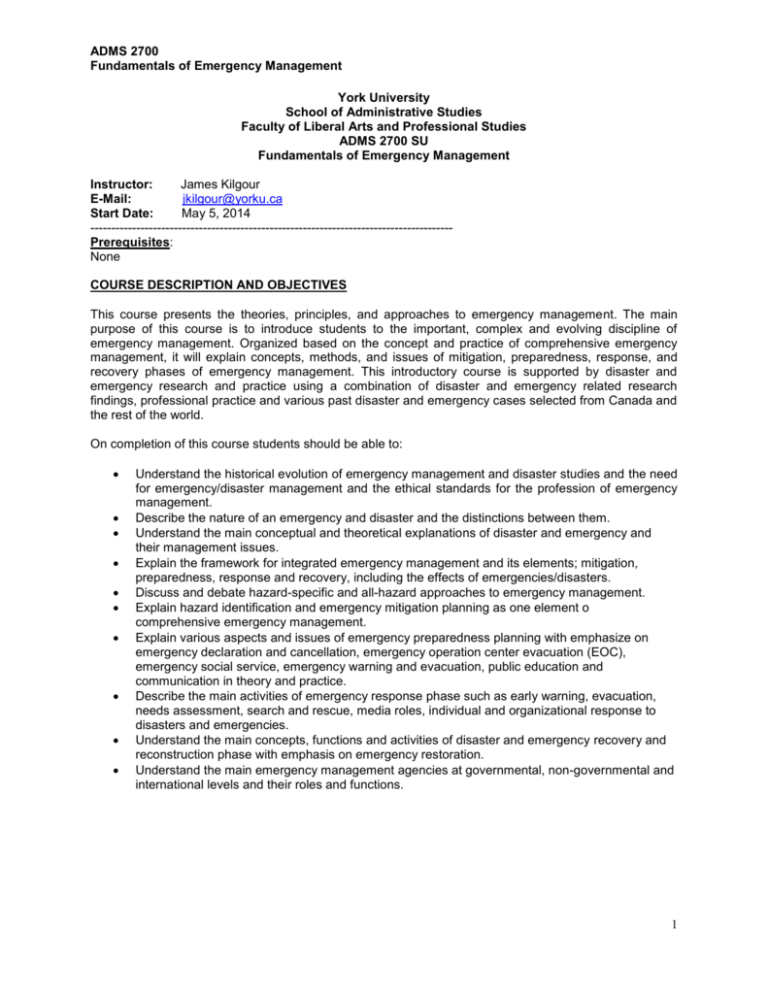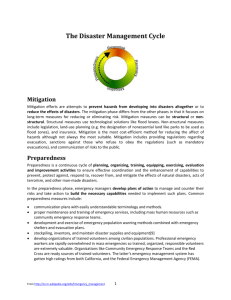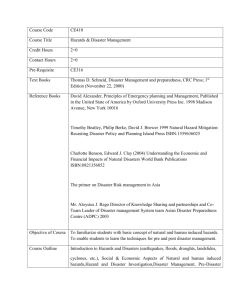On-line - Faculty of Liberal Arts & Professional Studies
advertisement

ADMS 2700 Fundamentals of Emergency Management York University School of Administrative Studies Faculty of Liberal Arts and Professional Studies ADMS 2700 SU Fundamentals of Emergency Management Instructor: James Kilgour E-Mail: jkilgour@yorku.ca Start Date: May 5, 2014 --------------------------------------------------------------------------------------Prerequisites: None COURSE DESCRIPTION AND OBJECTIVES This course presents the theories, principles, and approaches to emergency management. The main purpose of this course is to introduce students to the important, complex and evolving discipline of emergency management. Organized based on the concept and practice of comprehensive emergency management, it will explain concepts, methods, and issues of mitigation, preparedness, response, and recovery phases of emergency management. This introductory course is supported by disaster and emergency research and practice using a combination of disaster and emergency related research findings, professional practice and various past disaster and emergency cases selected from Canada and the rest of the world. On completion of this course students should be able to: Understand the historical evolution of emergency management and disaster studies and the need for emergency/disaster management and the ethical standards for the profession of emergency management. Describe the nature of an emergency and disaster and the distinctions between them. Understand the main conceptual and theoretical explanations of disaster and emergency and their management issues. Explain the framework for integrated emergency management and its elements; mitigation, preparedness, response and recovery, including the effects of emergencies/disasters. Discuss and debate hazard-specific and all-hazard approaches to emergency management. Explain hazard identification and emergency mitigation planning as one element o comprehensive emergency management. Explain various aspects and issues of emergency preparednessplanning with emphasize on emergency declaration and cancellation, emergency operation center evacuation (EOC), emergency social service, emergency warning and evacuation, public education and communication in theory and practice. Describe the main activities of emergency response phase such as early warning, evacuation, needs assessment, search and rescue, media roles, individual and organizational response to disasters and emergencies. Understand the main concepts, functions and activities of disaster and emergency recovery and reconstruction phase with emphasis on emergency restoration. Understand the main emergency management agencies at governmental, non-governmental and international levels and their roles and functions. 1 ADMS 2700 Fundamentals of Emergency Management READINGS Required Text Damon Coppola, 2011, “Introduction to International Disaster Management”, Butterworth-Heinemann. In addition to the textbook there will be some reading materials to supplement the text. These readings are available for you to download for free on the course website in Moodle. USE OF TECHNOLOGY Course on Moodle This course uses Moodle for information sharing. All students who register for this course are requested to activate their Moodle service. Once activated, students can access Moodle for this course by logging into “moodle.yorku.ca” using their York ID and Password. All course materials, announcements, assignments and course outline are posted in this site. METHODS OF INSTRUCTION: The teaching method is a combination of: On-line Case studies. The following case studies will be cited throughout this course: Chernobyl Nuclear Disaster (1986) Bhopal Disaster (1984) Love Canal (1976) Cuyahoga River Fire (1969) Centralia – The Town That Was (1962-) Exxon Valdez (1989) BP Texas Oil City Fire (2005) Three Mile Island (1979) Hurricane Katrina (2005) – Recovery (2010) G20 Summit Toronto (2010) BP Deepwater Horizon (2010) Minamata Disease (1956) H1N1 (2009) SARS (2003) PowerOutage (2003) Air France Crash Toronto (2005) G20 (2010) Southern Alberta Floods (2013) July 8th Severe Storm Toronto (2013) December Ice Storm (2013) 2 ADMS 2700 Fundamentals of Emergency Management COURSE EVALUATION Type Written Assignment # 1 On-line Discussions Essay Final Exam Total Disaster Management Cycle Postings and Responses Weight 15% 10% 35% 40% 100% All final grades will be reviewed by the School of Administrative Studies, and the School reserves the right to modify them in order to maintain high standards. Late Assignments Late assignments will be penalized at 5% per day. DETAILED COURSE OUTLINE Lesson 1: The Management of Disasters Disaster management is a risk-based program consisting of prescribed elements that assist an organization or government in mitigating, preparing, responding and recovering from a risk. The purpose of this week is to discuss the historical evolution of disaster management, examine the disaster management cycle, define the phases of disaster management and examine the five disaster management trends. Highlighted this week will be current issues and challenges of implementing an effective and efficient disaster management program. Topics To Be Covered Disasters and Emergencies throughout History The History of Disaster and Emergency Management Modern Disaster Management Disaster Management Cycle Response and Recovery-based efforts Prevention and Risk Reduction based-efforts Disasters, Poverty, and Development Disaster Trends Definitions LEARNING OUTCOMES Define o Disaster management; o Hazard o Risk o Vulnerability o Disaster Describe the four phases to disaster management and provide Canadian examples o Mitigation; o Preparedness; o Response; and 3 ADMS 2700 Fundamentals of Emergency Management o Recovery Illustrate the Disaster Management Cycle Describe the 5 'Disaster Trends' and differentiate how those trends impact between a developed and a developing country Required Readings: Chapter 1: The Management of Disasters (text book) Recommended Readings Crews, D.T. (2001), "The case for emergency management as a profession", Australian Journal of Emergency Management, Vol. 16 No.2, pp.2-3 http://www.ema.gov.au/www/emaweb/rwpattach.nsf/VAP/(3A6790B96C927794AF1031D9395C5C20)~ca se_for_emergency_management_as_a_profession.pdf/$file/case_for_emergency_management_as_a_pr ofession.pdf Public Safety Canada: An Emergency Management Framework for Canada Second Edition, Ministers Responsible for Emergency Management http://www.publicsafety.gc.ca/prg/em/_fl/emfrmwrk-2011-eng.pdf Scanlon, J. (2001), "Lessons Learned or Lessons Forgotten: The Canadian Disaster Experience" The Institute for Catastrophic Loss Reduction http://www.iclr.org/publicpolicycanadianexp.html 4 ADMS 2700 Fundamentals of Emergency Management Lesson 2: Hazards Hazard identification and risk assessments are the cornerstone to an effective disaster/emergency management program. This week we will examine hazards and the hazard profiling process that allows community and organizations mitigate, prepare, respond and recovery from hazards and risks. Topics To Be Covered Hazard Identification and Hazard Profiling Hazard Analysis Types of Hazards Event Tree Fault Tree Risk Statement LEARNING OUTCOMES Define: o Natural Hazards o Technological Hazards o Intentional Hazards Describe the 7 types of hazard identification methods Compare and contrast event trees and fault trees and be able to give examples for each Identify and explain the 5 elements of a community risk profile Compare and contrast the difference between an emergency, disaster and a catastrophe Required Readings: Chapter 2: Hazards (text book) Lesson 3: Risk and Vulnerability Understanding risk and vulnerability assists the disaster management professional in establishing program priorities and a community/organization risk profile. This week we will discuss the risk assessment process – basically: “What can cause harm and the chances of that actually happening to you, your community or organization?” Topics to be Covered Two Components of Risk Trends Computing Likelihood and Consequence Values Risk Evaluation Alternatives Vulnerability LEARNING OUTCOMES Describe the two components of risk 5 ADMS 2700 Fundamentals of Emergency Management Distinguish between qualitative and quantitative methods Design a risk matrix Arrange hazards in a risk matrix Explain risk acceptability Explain vulnerability and describe the risk factors that influence vulnerability Describe the concept of risk perception Required Readings: Chapter 3: Risk and Vulnerability (text book) Optional Reading Global Risks 2012 - Seventh Edition http://www.weforum.org/reports/global-risks-2012-seventh-edition Risk Assessment and Management in Local Government Emergency Planning http://www.iclr.org/images/Risk_assessment_and_management_in_local_government_emergency_planni ng.pdf Community Risk in Mackay http://www.ga.gov.au/image_cache/GA4186.pdf City of Greater Sudbury Hazard Identification and Risk Assessment http://www.greatersudbury.ca/content/div_emergprep/documents/hira_report_2010_final.pdf Lesson 4: Mitigation Topics to be Covered What is Mitigation Structural vs. Non-Structural Mitigation Obstacles to Effective Mitigation Assessing and Selecting Mitigation Options Emergency Response Capacity as a Risk Mitigation Measure Incorporating Mitigation into Development and Relief Projects LEARNING OUTCOMES Define mitigation Explain the difference between structural and non-structural mitigation and provide local, provincial/state and federal examples Analyse the six factors that impact the probability mitigation will be implemented Describe and apply the STAPLEE method to a local, provincial/state and federal mitigation project Define and discuss the goals of mitigation 6 ADMS 2700 Fundamentals of Emergency Management Required Readings: Chapter 4: Mitigation (text book) Optional Readings Natural Hazards Education in Australian Schools: How Can we Make it More Effective? http://www.ema.gov.au/www/emaweb/rwpattach.nsf/VAP/(966BB47E522E848021A38A20280E2386)~aje m+24+2+natural+hazards.pdf/$file/ajem+24+2+natural+hazards.pdf Multi-Hazard Mitigation Planning http://www.fema.gov/plan/mitplanning/index.shtm ESTABLISHING MITIGATION AS THE CORNERSTONE FOR COMMUNITY RESILIENCE http://oregonexplorer.info/data_files/OE_topic/hazards/documents/PERI_YR_Book_LeDuc_01_06_06_pri nt.pdf Lesson 5: Preparedness Topics to be Covered Overview of Disaster Preparedness Government Preparedness Public Preparedness Media as a Public Educator Obstacles of Public Education and Preparedness Public Awareness vs. Public Education Case Study: Risk Watch Required Readings: Chapter 5: Preparedness (text book) Lesson 5 Define preparedness Compare and contrast an all hazards versus a hazard specific plan Prepare a draft outline for an all hazards emergency plan Describe the purpose of an Emergency Operation Centre Differentiate the various types of exercises Give examples of elements of a personal preparedness program 7 ADMS 2700 Fundamentals of Emergency Management Lesson 6: Response Topics to be Covered What is Response Response – The Emergency Recognition – Pre-Disaster Actions Recognition – Post-Disaster Provision of Water, Food and Shelter Volunteer Management Coordination Case Study: Air France Crash, Three Mile Island Nuclear Emergency, SARS Required Readings: Chapter 6: response (text book) LEARNING OUTCOMES Lesson 6 Define response Analyse the three types of response action during the pre-disaster period Recognize the four main post-disaster response activities Draw conclusions on the complexity in providing water, food and shelter during a response Describe both volunteer and donation management Diagram and describe the incident command system 8 ADMS 2700 Fundamentals of Emergency Management Lesson 7: Recovery Topics to be Covered Overview of Recovery The Effects of Disasters on Society Pre-Disaster Recovery Actions Components of Recovery – What is needed, and where does it come from? Types of Recovery Public Assistance Special Consideration in Recovery Required Readings: Chapter 7: Recovery (text book) LEARNING OUTCOMES Lesson 7 Define recovery Compare and contrast with examples physical, physiological and economic recovery effects Describe the guiding principles of recovery Describe the types of recovery Appraise recovery efforts of previous emergencies/disasters 9 ADMS 2700 Fundamentals of Emergency Management Lesson 8: Participants Governmental Disaster Management Agencies Topics to be Covered Governmental Emergency Management Structures Emergency Management Participants Organizational Structures Bilateral Disaster Management Assistance How Governments Provide Assistance Types of Bilateral Assistance Types of National Government Agencies Involved in International Emergency Management Required Readings: Chapter 8: Participants - Governmental Disaster Management Agencies (text book) LEARNING OUTCOMES Lesson 8 Describe the organizational structure of disaster management in Canada Compare and contrast locally, regionally and nationally based disaster management structures Explain how government disaster management agencies provide assistance Describe the types of bilateral assistance 10 ADMS 2700 Fundamentals of Emergency Management Lesson 9: Participants - Nongovernmental Organizations Topics to be Covered Who Are the NGOs? What Do They Do? NGO Operations NGO / Military Cooperation Standards of Conduct The Role of the Private Sector The Role of Academia Required Readings: Chapter 9: Participants - Nongovernmental Organizations (text book) LEARNING OUTCOMES Lesson 9 Identify and give examples of the five types of nongovernment organization categories Explain what is the role of nongovernment organizations in disaster management Explain what is the role of the private sector in disaster management Explain what is the role of academia in disaster management Assess the code of conduct of nongovernment organizations 11 ADMS 2700 Fundamentals of Emergency Management Lesson 10: Multilateral Organizations and the International Financial Institutions Topics to be Covered The United Nations Regional International Organizations The International Financial Institutions Required Readings: Chapter 10: Participants - Multilateral Organizations and the International Financial Institutions (text book) Lesson 11: Special Considerations Topics to be Covered Coordination The Media Political Will Compound Emergencies Terrorism Global Disasters: SARS, Avian Influenza, and Other Emerging Epidemics Social Media Required Readings: Chapter 11: Special Considerations (text book) Lesson 12: July 8th Severe Storm in Toronto 2013 Lesson 13: December Ice Storm 2013 12 ADMS 2700 Fundamentals of Emergency Management RELEVANT UNIVERSITY REGULATIONS Deferred Exams: Deferred standing may be granted to students who are unable to write their final examination at the scheduled time or to submit their outstanding course work on the last day of classes. In order to apply for deferred standing, students must complete a Deferred Standing Agreement (DSA) form and submit their request no later than five (5) business days from the date of the exam. The request must be properly submitted with supporting documentation directly to the main office of the School of Administrative Studies (282 Atkinson), NOT to the Course Director. These requests will be considered on their merit. Students can check the status of their requests by logging in the link for Status of Deferred Exams Request: http://www.yorku.ca/laps/sas/links.html Students with approved DSA will be able to write their deferred examination during the School's deferred examination period. No further extensions of deferred exams shall be granted. The format and covered content of the deferred examination may be different from that of the originally scheduled examination. The deferred exam may be closed book, cumulative and comprehensive and may include all subjects/topics of the textbook whether they have been covered in class or not. Any request for deferred standing on medical grounds must include an Attending Physician's Statement form; a “Doctor’s Note” will not be accepted. DSA Form: http://www.registrar.yorku.ca/pdf/deferred_standing_agreement.pdf Attending Physician's Statement form: http://www.yorku.ca/laps/council/students/documents/APS.pdf The deferred exam period for the Summer 2014 term shall be held in the period of September 26, 27, 28, 2014. Academic Honesty: The School of Administrative Studies considers breaches of the Senate Policy on Academic Honesty to be serious matters. The Policy on Academic Honesty is an affirmation and clarification for members of the University of the general obligation to maintain the highest standards of academic honesty. As a clear sense of academic honesty and responsibility is fundamental to good scholarship, the policy recognizes the general responsibility of all faculty members to foster acceptable standards of academic conduct and of the student to be mindful of and abide by such standards. Suspected breaches of academic honesty will be investigated and charges shall be laid if reasonable and probable grounds exist. Students should review the York Academic Honesty policy for themselves at: http://www.yorku.ca/secretariat/policies/document.php?document=69 Students might also wish to review the interactive on-line Tutorial for students on academic integrity, at: http://www.yorku.ca/tutorial/academic_integrity/ Students must be aware of their rights and responsibilities, for more detail please visit: http://www.yorku.ca/laps/students/rights.html Grading Scheme and Feedback Policy: The grading scheme (i.e. kinds and weights of assignments, essays, exams, etc.) shall be announced, and be available in writing, within the first two weeks of class, and, under normal circumstances, graded feedback worth at least 15% of the final grade for Fall, Winter or Summer Term, and 30% for ‘full year’ courses offered in the Fall/Winter Term be received by students in all courses prior to the final withdrawal date from a course without receiving a grade, with the following exceptions: Note: Under unusual and/or unforeseeable circumstances which disrupt the academic norm, instructors are expected to provide grading schemes and academic feedback in the spirit of these regulations, as soon as possible. For more information on the Grading Scheme and Feedback Policy, please visit: http://www.yorku.ca/secretariat/policies/document.php?document=86 In-Class Tests and Exams - the 20% Rule: For all Undergraduate courses, except those which regularly meet on Friday evening, on a weekend or are on-line, tests or exams worth more than 20% will not be held in the two weeks prior to the beginning of the official examination period. For further information on the 20% Rule, please visit: http://www.yorku.ca/secretariat/policies/document.php?document=141 For further information on examination scheduling please refer to the following: http://www.registrar.yorku.ca/enrol/dates/index.htm 13 ADMS 2700 Fundamentals of Emergency Management Reappraisals: Students may, with sufficient academic grounds, request that a final grade in a course be reappraised (which may mean the review of specific pieces of tangible work). Non-academic grounds are not relevant for grade reappraisals; in such cases, students are advised to petition to their home Faculty. Students are normally expected to first contact the course director to discuss the grade received and to request that their tangible work be reviewed. Tangible work may include written, graphic, digitized, modeled, video recording or audio recording formats, but not oral work. Students need to be aware that a request for a grade reappraisal may result in the original grade being raised, lowered or confirmed. For reappraisal procedures and information, please visit the Office of the Registrar site at: http://www.registrar.yorku.ca/grades/reappraisal/index.htm Accommodation Procedures: LA&PS students who have experienced a misfortune or who are too ill to attend the final examination in an ADMS course should not attempt to do so; they must pursue deferred standing. Other students should contact their home Faculty for information. For further information, please visit: http://www.registrar.yorku.ca/exams/deferred/index.htm Religious Accommodation: York University is committed to respecting the religious beliefs and practices of all members of the community, and making accommodations for observances of special significance to adherents. For more information on religious accommodation, please visit: https://w2prod.sis.yorku.ca/Apps/WebObjects/cdm.woa/wa/regobs Academic Accommodation for Students with Disabilities: The nature and extent of accommodations shall be consistent with and supportive of the integrity of the curriculum and of the academic standards of programs or courses. Provided that students have given sufficient notice about their accommodation needs, instructors shall take reasonable steps to accommodate these needs in a manner consistent with the guidelines established hereunder. For more information please visit the Disabilities Services website at http://www.yorku.ca/dshub/ York’s disabilities offices and the Registrar’s Office work in partnership to support alternate exam and test accommodation services for students with disabilities at the Keele campus. For more information on alternate exams and tests please visit http://www.yorku.ca/altexams/ Please alert the Course Director as soon as possible should you require special accommodation. 14







